A Tour of Apple Music
Apple Music has launched with much fanfare, giving iOS and Mac users access to streamed music from the iTunes Store, iCloud-based synchronization of your existing music library across multiple devices, the Beats 1 streaming radio station, and the Connect service for interacting with artists.
As soon as you open the Music app in iOS 8.4, you’re invited to join the new music streaming service, with a free three-month trial as an enticement.
Naturally, I’m going to assume that you did just that, because hey, why not? For that reason, I’m not going to bore you with a detailed walkthrough and review, because much of it is obvious and you can easily decide for yourself if the service is for you.
However, not everything about Apple Music is obvious, and let’s be honest, the company did a horrible job of describing it at the WWDC keynote (see “Apple Announces Apple Music Service,” 8 June 2015), so I’d like to share a number of tips and observations so you’ll get the most out of your three-month trial.
Individual or Family? — When you’re signing up for Apple Music, you have to make a decision: do you want an individual membership for $9.99 per month or a family membership for $14.99 per month?
Here’s what to consider. The family membership allows up to six people to share your Apple Music membership, all while maintaining their own profiles and preferences. But there’s a catch: it can be shared only within your Family Sharing circle.
As we explained in “iOS 8: TidBITS Answers Your Questions,” (17 September 2014), Family Sharing is a feature that lets you share App Store, iTunes Store, and iBooks Store purchases with up to five other people in your immediate family. But it doesn’t include iTunes Match and has other drawbacks too, as pointed out by Mac blogger David Sparks.
If you have more than one person in your household who will want Apple Music, the family membership is a no-brainer… unless you don’t use or want to use Family Sharing. In that case, the calculus becomes more complex. Your family members could each choose to have individual plans, for $9.99 per month, but that gets expensive fast.
You might think you could share an account if you and your spouse have similar tastes, for instance, but since the individual membership allows you to stream to only one device at a time, it may be awkward if your desired play times (in different locations or on different devices) overlap.
Turn Off Auto Renewal — With the three-month free trial, Apple is being generous, but also sort of sneaky, since by default, the company will begin charging you automatically once your trial is over. Here’s how you can prevent that in iOS.
- Open the Music app and tap the head icon in the upper left.
- Tap View Apple ID.
- Enter your Apple ID password.
- Under Subscriptions, tap Manage.
- Tap Your Membership, which should show an Active status.
- Disable Automatic Renewal.
Or in iTunes:
- Choose Account > View Account.
- Under Settings, find Subscriptions, and click the corresponding Manage link.
- Click Edit, to the right of Your Membership.
- Under Automatic Renewal, select Off.
- Click Done.
Whew, that was a surprising number of steps! Whatever happened to “no step three?”
Note that even if you do not decide to stick with Apple Music, Beats 1 and Connect are free, and will remain available.
Behind the Music — In iOS, Settings > Music offers some settings that may interest you.
The first is Show Apple Music, which toggles the Apple Music interface in the Music app. As I mentioned in “Apple Releases iOS 8.4 with Apple Music” (30 June 2015), the Music app has two distinct interfaces, depending on whether or not Apple Music is enabled. So if for whatever reason, you want to revert to the “normal” Music interface, you can do so with this switch.
The second is iCloud Music Library, which you may have some trouble enabling, due to Apple’s server overload. If you’re persistent, it will eventually stick. But what does it do?
iCloud Music Library essentially replaces iTunes Match, although iTunes Match is still offered as a separate product. As the name suggests, iCloud Music Library is just like iCloud Photo Library, but for your music. Whatever songs and playlists you add to My Music on one device will be synced to the others, at least in theory. I’ve found that it works pretty well, uploading or matching all of my music, without clogging my Internet connection like iCloud Photo Library.
Although I let my iTunes Match subscription expire months ago, those tracks were apparently still stored in iCloud, as iCloud Music Library synced those to the iPhone hours before the iTunes update arrived.
But there is a major catch, and a reason why iTunes Match still exists: when iCloud Music Library syncs your tracks, those new files are encumbered by DRM, and will vanish when your Apple Music membership expires. So, if you upload your music library, delete it for some reason, and then cancel Apple Music, you will suddenly find yourself with no music library at all. Or, even if you don’t cancel Apple Music, if you delete your main music library, the tracks you’d get from iCloud Music Library would all have DRM on them. In other words, don’t delete your main music library, and don’t assume that iCloud Music Library is a
backup, since it’s not.
The good news with iCloud Music Library is that the service is offered to everyone in your Family Sharing circle, so it solves the aforementioned problem of iTunes Match not being included in Family Sharing.
Customize, Customize — The For You view suggests albums and playlists tailored to your tastes. To get started, tell Apple Music which genres you like and don’t like by tapping the buttons. If you’re familiar with Apple Music’s ancestor, Beats Music, this screen will look familiar. Tap a genre bubble once to indicate that you like it, and watch the bubble grow. Tap it again to indicate that you love it, and watch it grow even larger. To delete a genre entirely on iOS, press and hold a bubble; a countdown appears, after which the bubble vanishes. In iTunes, just click the “x” on the button. If you make a mistake, you can tap Reset to start over.
Next, you’ll be prompted to voice your preference on specific artists, using the same bubble interface. I found this part frustrating, as the selection of artists was limited, and mostly outside of those I listen to. Yes, I love Jimi Hendrix and like Van Halen, but they’re not artists I listen to every day.
Thankfully, Apple Music is smarter than it seemed. It figured out that if I like Hendrix and country, then I’d probably also like Johnny Cash and Willie Nelson. Some of its other suggestions are more perplexing, and I hope it will improve over time. Others, such as designer Khoi Vinh, have had less than stellar results; he’s unimpressed that Apple couldn’t do better out of the gate, given how much data the company has available about our
musical preferences.
If your tastes change over time, you can rejigger them, at least in Music on iOS. Tap the head icon in the upper left, and tap Choose Artists For You to change your preferences.
You can also tailor your preferences on the fly. Tap the heart on a song or a playlist to tell Apple Music that you like it. That heart is now a prominent icon across all of Apple’s music platforms, including iTunes and even the Now Playing glance on the Apple Watch.
Unfortunately, there is no list of favorited songs and playlists. To add a song to your music collection, you either need to tap the + button or tap the … button and choose Add to My Music. I think Apple should have combined these two buttons, because if I like a song, why wouldn’t I want it in my collection?
35 Million Songs and Nothing to Listen to — You might recall from “A Visit to Pandoland, Where Silicon Valley Meets Music City,” (20 June 2015), Marc Ruxin of Rdio pointed out that the biggest challenge that music streaming services face is “35 million songs and nothing to listen to” — meaning that users are often left to their own devices to discover music they might like.
Like Rdio, Spotify, and similar music streaming services, once you subscribe to Apple Music you’re free to listen to whatever you want, with some limitations. Apple has been cagey about just how many tracks Apple Music offers (it’s not the full iTunes Store catalog), but I’ve found the selection to be as good as, if not better than, any of its competitors. Apple Music already has a few exclusives, such as Dr. Dre’s “The Chronic” and Taylor Swift’s “1989” that you won’t find on any other streaming service. It also has Led Zeppelin, which was previously available only on Spotify. However, it doesn’t yet
have The Beatles.
When you find an artist, like Beats Music before it, Apple Music gives you a detailed artist bio and recommends similar artists.
But Apple Music goes even further in trying to find stuff for you to listen to, and here’s where its roots in Beats Music shine. There’s the aforementioned For You section with personalized recommendations. There’s the New section, with a smorgasbord of newly added content. iTunes Radio is still sort of there, as well, though it has been somewhat neutered (see Missing Features below).
The human-curated playlists of Beats Music are still around, so there’s stuff like “Intro to Taylor Swift” that gives you an overview of an artist’s work. There are thousands of available playlists, some incredibly specific, like “Somethin’ ‘Bout a Truck: Country Pickup Truck Songs” and “Workout Anthems — Rock.” Dig around enough, and you’re sure to find a playlist you’ll love.
And there’s also Beats 1, Apple’s live, worldwide radio station with human curated content.
Beats 1 Killed the Video Star — Of all the features in Apple Music, Beats 1 might be the most fascinating, despite being an old idea: a live radio station manned by human DJs.
Many online commentators have rolled their eyes at Beats 1, making the joke that Apple has now “invented” FM radio. As someone with an analog Sony pocket radio on his desk, I say these snarky commenters are missing the point.
Chances are, outside of college radio, it has probably been decades since you listened to a radio station where the DJs actually picked the music. As radio stations consolidated, music selection was ripped from the DJs’ hands, decided instead by computer algorithms and the marketing departments of record labels. You’ll rarely be surprised by what’s played on the radio. Here in the Nashville broadcast area, some of the country stations are so pre-planned that you can literally set your watch to them.
What Beats 1 brings is the unexpected. I happened to catch Zane Lowe’s Beats 1 kickoff. Lowe gave a brief rundown of the philosophy of Beats 1 before playing the first song. “It’s not about fanfare, that’s fireworks and a hangover the next day. It’s about quality and consistency,” he said before kicking off Beats 1 with “City” by Spring King.
It was a surprising choice, and one that I think few listeners had previously heard. He followed it up with the new Beck single, “Dreams,” then later brought out AC/DC’s “For Those About to Rock.” Throughout the first day, I kept tuning into Beats 1, never knowing what I’d hear next. Sometimes it was hip-hop, sometimes electronica. I never heard country, jazz, or classical, but I wouldn’t be surprised if they were slipped into the mix at some point.
I’ve also heard some folks say, “Beats 1 doesn’t play anything I like.” To me, that’s the equivalent of asking, “Where’s my parade?” You’re not going to like every song played on Beats 1, and that’s kind of the point (though, of course, those who find they dislike most of what Beats 1 plays are unlikely to tune in more than once). Beats 1 exists to expose you to stuff you otherwise wouldn’t know exists. If you have highly specific tastes in music, Apple Music offers plenty of other options for you.
What makes Beats 1 exciting is personality. Like any great media venture, its beginnings feel rough around the edges. The playlists are haphazard, the DJs say crazy, off-the-cuff things like, “I’m going to take your kids away and give you a headphone moment,” and in true Apple fashion, there was an outage on the first day. It doesn’t feel like a media venture from the world’s biggest company, but instead like a pirate radio station down the street. In a word, it’s fun.
The other great thing is the social factor. Beats 1 provides a single, shared experience, so you can go on Twitter and Facebook and have a conversation about the thing you’re listening to. In today’s fragmented media world, Apple might be one of the few companies that can provide a shared experience for millions of people.
I’ve also found that Beats 1 acts as a home base for Apple Music. It’s what I turn to when I can’t think of anything to play.
Some have said that Beats 1 is very unlike Apple, but I disagree. It perfectly mixes technology and humanity, and isn’t that Apple’s very core?
Like any other radio station, you can request a song. Apple World Today has compiled a list of all the ways to request a song, including a Twitter hashtag, iMessage, and even old-fashioned phone lines.
Another neat feature of Beats 1 is a weekly show, hosted by singer St. Vincent, where she creates a custom playlist for a random lucky fan. How’s that for personalization?
Note that Beats 1 censors explicit content from the songs it plays. Some have complained about that, but it’s a smart move. Parents can play Beats 1 with their kids in the car, and businesses can play Beats 1 without fear of offending customers. If you want to hear explicit content, you can find the uncensored songs on Apple Music.
Hello Connect, My Old Ping — The last major component of Apple Music is Connect, a social network where you can follow your favorite artists. You might remember its first incarnation, Ping.
Ping lived a short, unhappy life, and to this day, it’s still the butt of jokes. But Ping wasn’t a terrible concept, it was just executed terribly. It added clutter to iTunes without much value. As much as we like each other, my wife and I have very different musical tastes, so even we seldom care about what the other is listening to.
Connect is more subdued than Ping. First of all, it lives in its own pane, out of the way. Second, while there isn’t much there yet, what’s there is actually interesting. For example, Trent Reznor of Nine Inch Nails, one of the brains behind Apple Music, has posted instrumental versions of some of his albums, a concert video, and a backstage picture of himself with Lou Reed. Nothing earth-shattering, but hardcore Nine Inch Nails fans were thrilled.
Out of the gate, Connect automatically follows every artist it can find in your iTunes library. To change who you follow on iOS, tap the head icon in the upper left and tap Following. Then you can choose to stop following artists automatically, find more artists and curators, and unfollow artists.
Happily, if you don’t care about Connect, you can disable it entirely in Settings > General > Restrictions > Apple Music Connect. You will have to enable restrictions, but that in itself doesn’t do anything other than allowing you to enable individual restrictions. Disabling Apple Music Connect replaces the Connect tab with a more useful Playlists tab.
Missing Features — Apple Music is essentially the love child of iTunes and Beats Music, so it was inevitable that the kid wouldn’t have all of the features of both of its parents.
One of Beats Music’s unique features, The Sentence, is absent in Apple Music. As you may recall from “FunBITS: What Sets Beats Music Apart” (16 May 2014), The Sentence let you create custom playlists by filling in the blanks in a Mad Libs-style interface. So you could create a sentence like “I’m in the club and feel like saving the world with no regrets to indie.” I can see why Apple dropped it, as it was as baffling as it was novel, but I’m still sad to see it go. I hope Apple eventually brings it back in some form, with Siri support.
Another Beats Music innovation I miss is the circular scrubber around the play/pause button for rewinding and fast-forwarding. Again, I see why Apple dropped it for something more familiar, but I liked it, as it reminded me a bit of the iPod click wheel.
There’s one last missing feature that grinds my gears. Remember iTunes Radio, Apple’s Pandora clone that would play music related to a particular song or artist? It still exists, but is barely recognizable. Previously, you could start adding a new station, specify an artist or song you like, and then create your station, but now it’s not as obvious. Don’t worry, though; your existing stations are still there.
You can still create a custom station, but you do so by searching for an album, artist, genre, or song, scrolling down to the Stations heading, and then choosing that station. For instance, if I wanted to make a station based on “Where Is My Mind?” by the Pixies, I would search for that song, scroll down, and then tap Where Is My Mind? Radio under the Stations heading. You can also create a station directly from a song you’re listening to. On those custom stations, you can tap the star (which replaces the heart) while listening to tune the station to play less of or more of that type of music.
There’s another way to create a custom station on the fly: Siri. Just tell Siri something like “play AC/DC radio.” In fact, one of the best things about Apple Music is its Siri integration, which makes possible commands like “play Beats 1” or “play 1989” (where Siri guessed at Taylor Swift’s new album correctly, despite the ambiguous name).
But outside of favoriting tracks, the rich editing options previously available in iTunes Radio are gone. Want to exclude Nickelback from your rock station? Too bad, so sad. This is a huge step backwards, for no good reason.
To make things confusing, Apple has also added human-curated stations, like Pure Pop and The Mixtape, which cannot be customized.
Jim Dalrymple has explained Apple’s radio reasoning. The idea behind the curated stations is that Apple doesn’t want you to worry that favoriting or skipping a song will mess up your station. Apple hopes that the new curated stations will produce more songs you like, resulting in fewer skips. However, if you’re listening to a station you created yourself, or a station you started by searching for a specific artist or song, the heart becomes a star, and tapping the star while listening to a song gives you options to play more or less of that kind of song. So you can’t fine-tune the Classic Rock station, but you can tailor Hank Williams
Radio. I understand Apple’s reasoning, but I still miss the more detailed per-station settings.
Going back to missing features, as I write this, Apple Music isn’t yet appearing on the Apple TV. On the upside, you can still customize your iTunes Radio stations there. Poor Apple TV, why has Apple forsaken thee? Apple Music support is surprisingly spotty on the Apple Watch. You can control playback and favorite songs from the watch, but you can’t directly access any content not specifically added to My Music, including Beats 1.
WTF, iTunes? — iOS 8.4, with Apple Music support, launched on 30 June 2015 at 11 AM Eastern time, which was crucial, because Beats 1 launched one hour later. iTunes 12.2, which brought Apple Music to the Mac, didn’t appear until several hours later, at the end of the day (see “iTunes 12.2,” 1 July 2015).
Many assumed that there was some snafu at Apple’s end, but I think it was a deliberate decision. While Apple Music in iOS is a pretty good experience, it is a train wreck on the desktop. And I stop at “train wreck” only because TidBITS is a family friendly publication.
Start with iTunes 12’s labyrinth of an interface. Now, add three new tabs when Music is selected on the left: For You, New, and Connect. That’s the baseline.
From there, add in the fact that Apple Music was clearly designed as mobile first, with the desktop a distant afterthought. Look at all the white space in the Connect pane.
Then, stir in a good dose of bugs. For example, when I checked my For You preferences, the bubbles inexplicably drifted to the right side of the screen, and even off of it. I started to wonder if my desk was level.
Finally, there’s the fact that iTunes is missing a number of Apple Music settings. There’s no way to change who you’re following in Connect, or any way to change your For You pane from iTunes. Those capabilities exist only in iOS. To say that Apple Music feels like an afterthought on the Mac is being kind.
Apple, this is sloppy work at best. It would have been better to hold off on releasing Apple Music on the desktop than to release it like this. Perhaps the problem is iTunes, which needs to be rethought completely. It’s a program that was originally designed for ripping, sorting, and playing MP3s that has since had grafted onto it a music store, a video player, a video store, a podcast player, an app store, iOS device management capabilities, and now a subscription music service. If iTunes were a car, it would be a Model T with stability control, GPS navigation, and a front-end loader tacked on, marketed as “new for 2015.”
The Beats Goes On — Despite my reservations, I’ve found Apple Music more compelling than any other music service I’ve tried. It’s great to see Beats Music’s curated playlist and recommendation engine reaching a broader audience. On paper, it hits everything I want in a music service: a broad track selection, multiple “jump-off” points for discovering new music, integration with my existing music library, and clients for both the Mac and iOS.
But my reservations are pretty major. I hate how it applies DRM to music I already possess, and I also hate what Apple has done to iTunes Radio. The iTunes interface is awful, though usable. These are all things that Apple could fix, but I doubt it will, at least any time soon.
Even in iOS, Apple Music is the most complex streaming service I’ve used. For instance, just the sheer number of options presented when you tap the … button is overwhelming. It seems as though there are hidden options and settings scattered everywhere, so I never feel like I have a grasp on the interface.
I’ve also noted a disturbing trend in Apple Music. With Beats 1, Apple is seeking to direct musical taste. With iCloud Music Library, Apple is applying DRM control to music you already own. And Apple has also inexplicably removed most user control over algorithmic radio stations. Even the innocent-looking Connect has the undertone of Apple mediating the relationship between artists and fans. Everywhere I look, I see Apple trying to take control of music itself.
That seems like an outlandish claim, but think about it for a minute. Every aspect of Apple Music gives Apple a way to control the music market. Many unsuspecting trial users will find themselves locked in, and I’m willing to bet, so will artists and labels. With Apple even publicly negotiating with major artists now, some are wondering how long will it be until Apple cuts the labels out entirely?
In the here and now, Apple Music is a potentially great product with some major kinks to work out. Let’s hope Apple can fix them inside the three-month trial. And that we’re not somehow handing the company the keys to our musical kingdom.
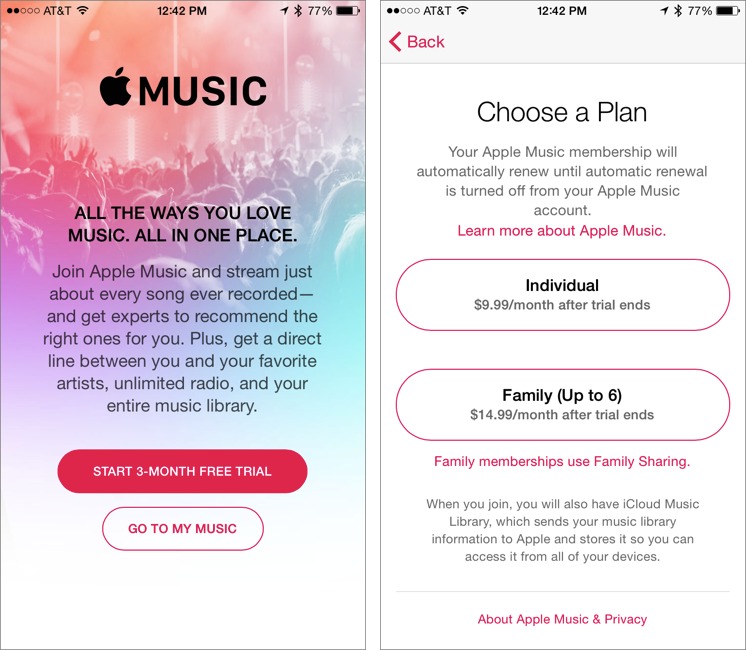
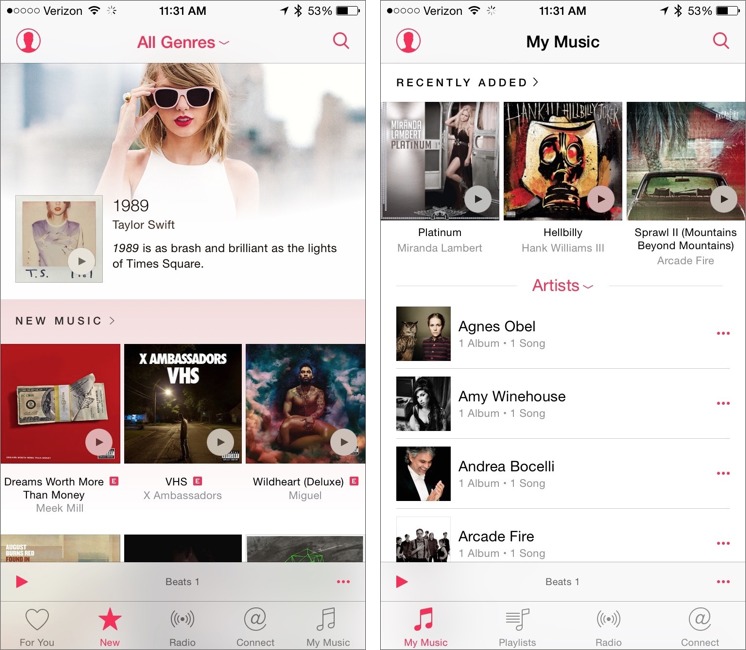
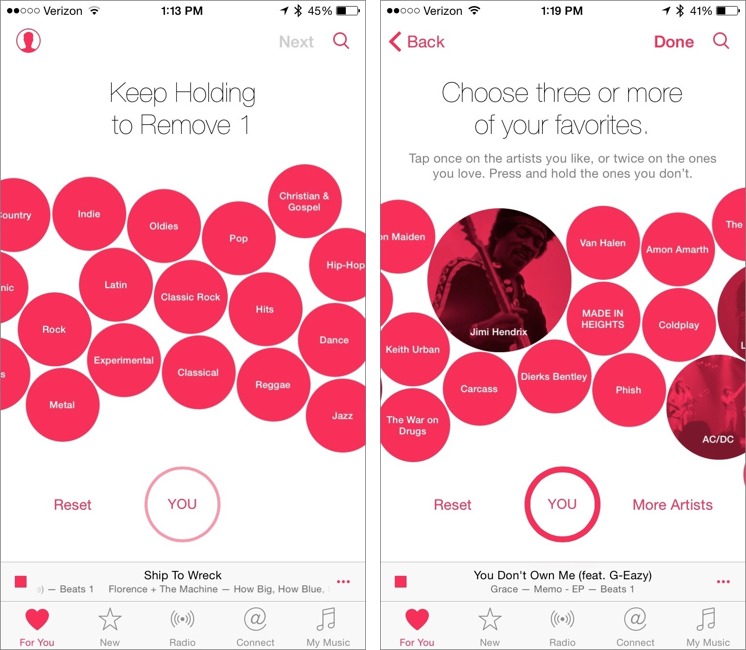
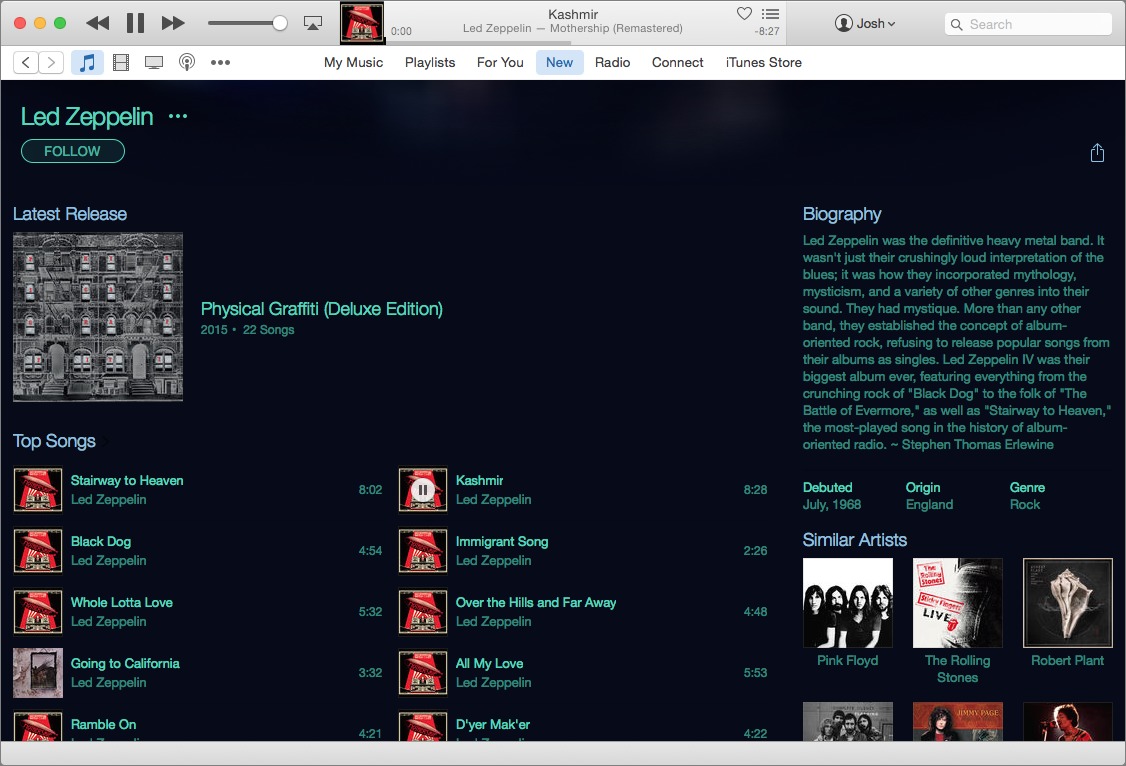
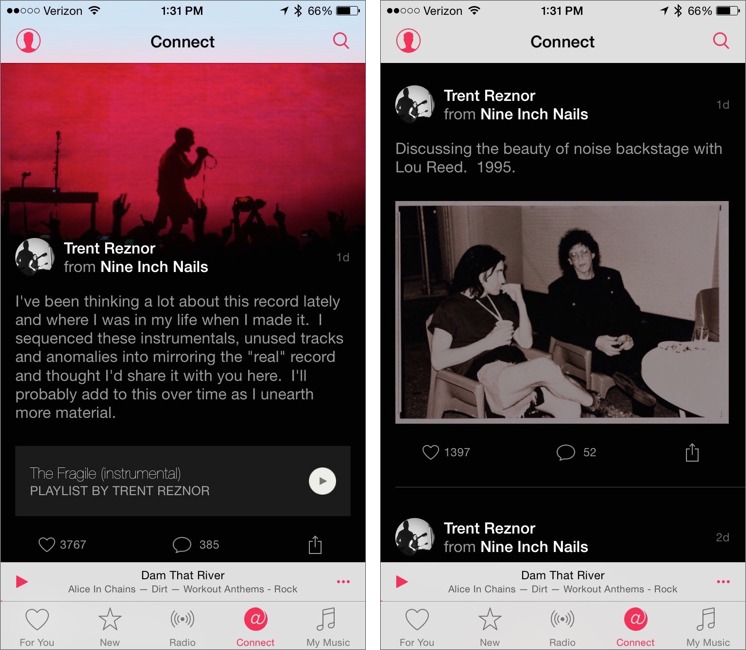

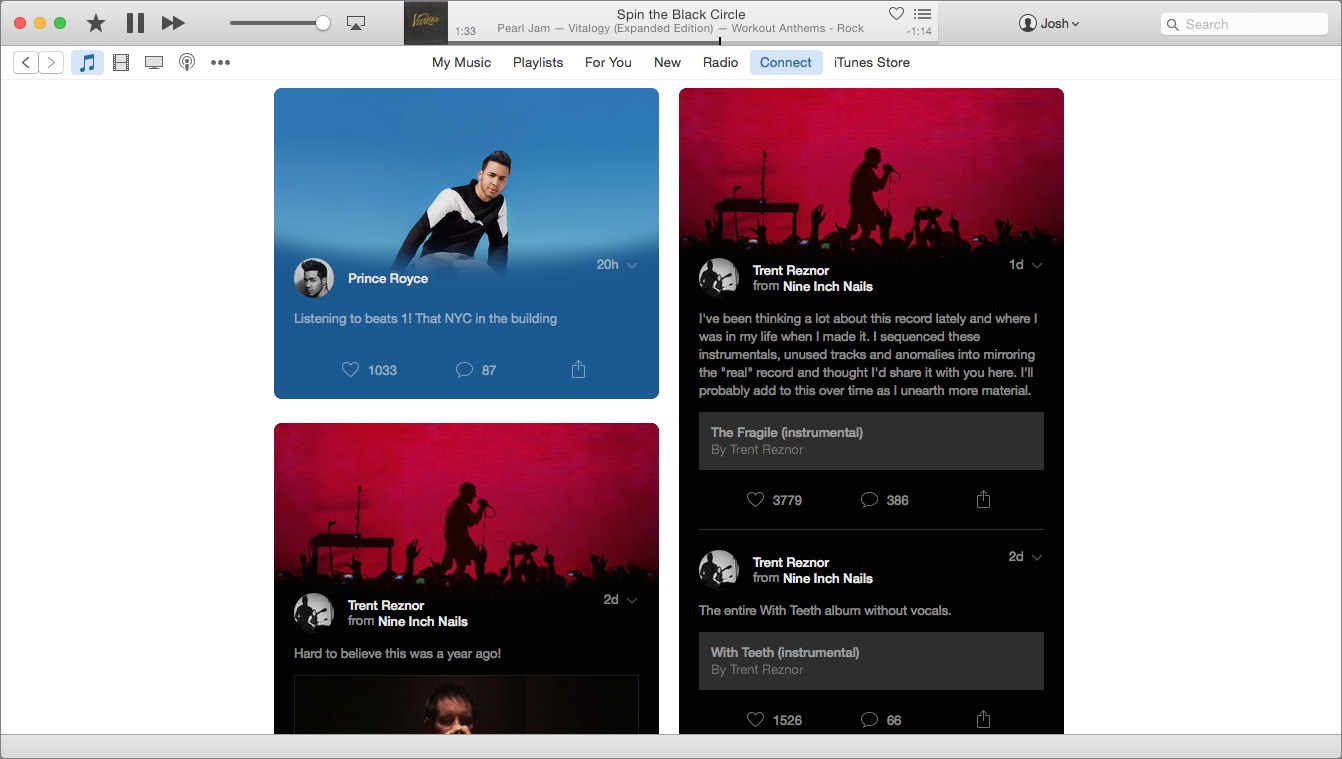
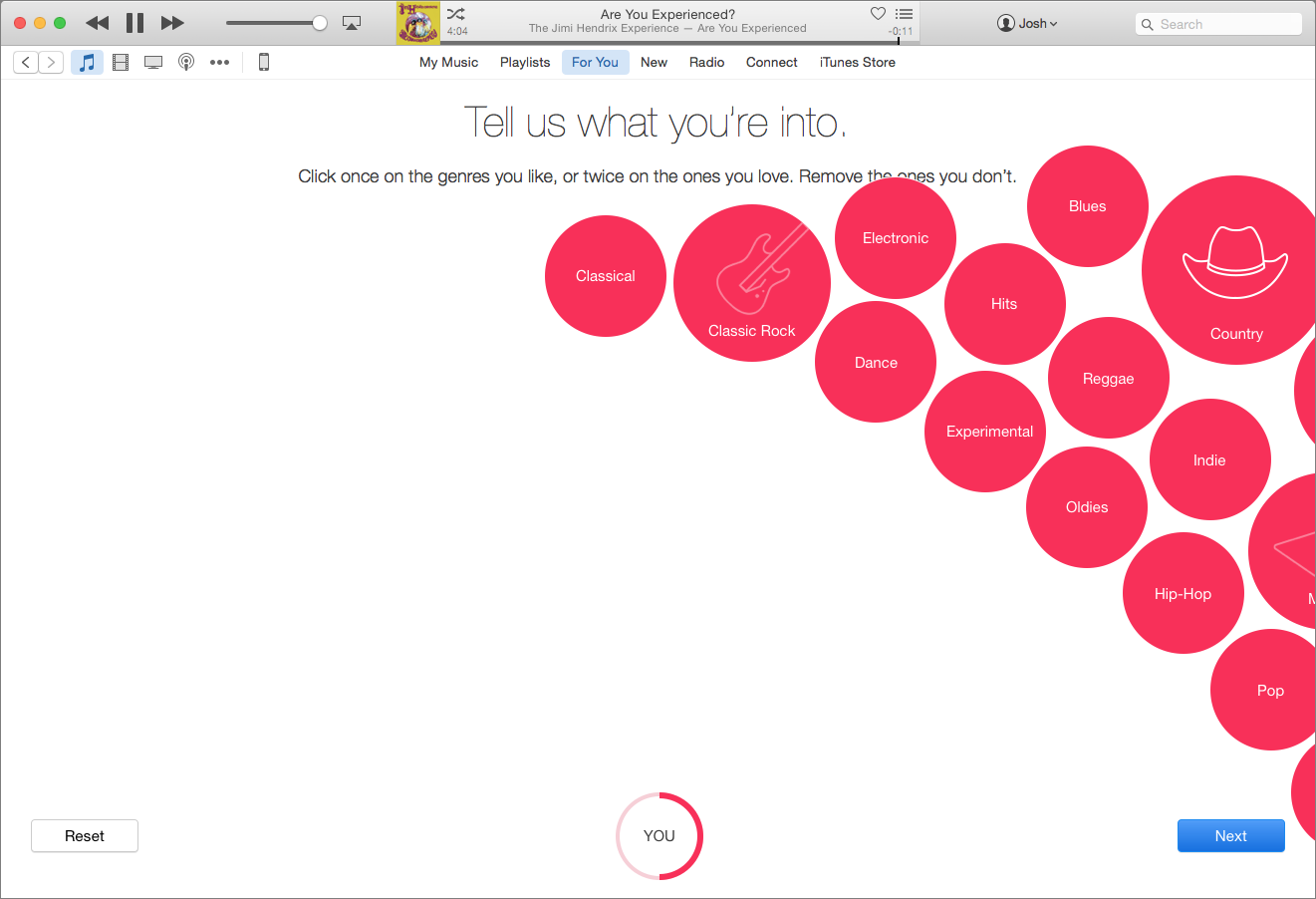
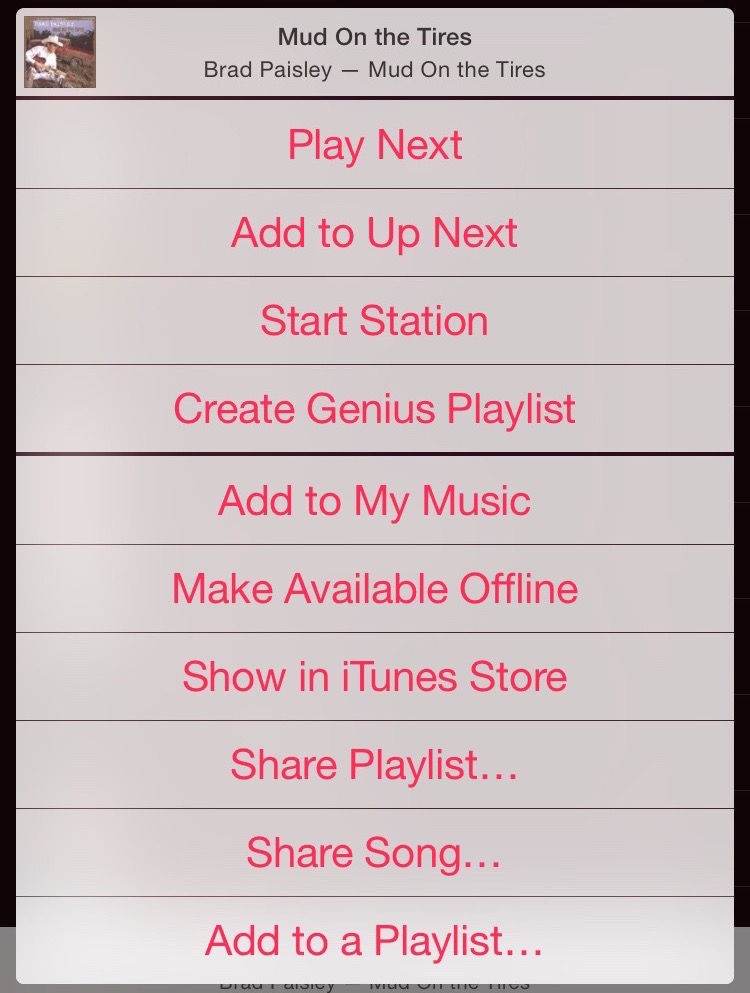
"I’ve also heard some folks say, “Beats 1 doesn’t play anything I like.”
I'm 99% sure that they aren't going to play anything that I like. Are they going to be playing medieval or Renaissance music? Big band jazz? Celtic, Breton, middle eastern, other traditional folk musics? Indian classical music? Even instrumental bluegrass? Doesn't seem all that likely…
I must be llving on another planet.
Everyone keeps repeating that Apple has an "exclusive" on Taylor Swift's "1989". Yet I've been listening to it on Pandora for many weeks. Does anyone fact-check these Apple Press Releases?
On the Mac, Apple should create a "Radio" app that is separate from iTunes. I have a collection of music going back 15 years and I'm not about to have Apple lay DRM on it! What do I get in return?
The difference is that with Apple Music, Rdio, and Spotify, you can directly choose what you listen to. Pandora and the like are more or less random. So yes, Apple Music is the only music subscription service (as opposed to Internet radio) that features "1989." Pandora also plays The Beatles, which isn't yet available for direct streaming.
A nice article. The problem for me is in the "For You" registration process. I can easily select the genres I like - but when it presents me with "bubbles" of artists to select I am at a loss. I have never even heard of the first list of artists I am presented, let alone being able to designate "like" or "dislike". As I ask for more artists, I see some names I recognize - but none that I listen to. It seems like it would be a lot more straightforward to allow users to search for artists they like - but that doesn't appear to be possible.
Thanks! Yes, I agree, I like the bubbles, but I'd like to have a search box that would enable me to pick my own artists. However, I'm finding that For You adapts to your tastes pretty fast despite that.
I'd like to point out a fairly major update/correction in the article. It turns out that you *can* still create custom stations manually, but it's just not as obvious. Instead of tapping a "+" button and entering an artist or song, you search for that artist or song, and then select the station from the list of results.
I misunderstood the functionality, because actually creating something by searching for it is something of an unusual idea. And that confusion was compounded by Apple's new pre-made stations.
I had seen the artist stations, but had assumed that they were pre-made by Apple. Apparently, they are generated on the fly, and can be customized by tapping the star while playing them.
However, you cannot customize the curated stations, as the selections are picked by human DJs. However, you can "love" them to indicate to Apple Music that you would like to see things like that in For You.
Other than starring songs, Apple has removed the station editing functionality, which is a shame, because I enjoyed having that granularity of control. So that complaint is still valid.
Sorry for the confusion!
To clarify: Apple does not add DRM to tracks you already own http://www.imore.com/no-apple-not-adding-drm-songs-your-mac-you-already-own
It does if you lose the local file and re-download from the cloud, as I explain in the article. The easy answer is to not do that, but that's not what iTunes Match has taught users to expect.
Note there is no way of distinguishing Apple Music "rented" music from your own purchased or otherwise added music.
This would seem to make managing your library dangerous - unless you intended to subscribe forever.
There is a way in iTunes. Under My Music, select the Song view, and enable the Kind column. Apple Music tracks are labelled as "Apple Music AAC audio file".
You can only follow artists for which your iTunes library contains a purchased track.
None of the tracks I've ripped from my own CDs have a Follow button.
I don't know if iTunes Matched tracks would qualify.
"Chances are, outside of college radio, it has probably been decades since you listened to a radio station where the DJs actually picked the music."
Not true - I regularly listen to Radio Paradise, a user-supported Internet radio station, whose music is selected by the couple that runs the service. Very eclectic mix of music - not unusual to hear a sequence of songs by people like The Who, Adele, John Coltrane, Leonard Cohen, and something by Beethoven. Lots of international music as well.
I listen to RP on their web page, on their iPad app, on their iPhone app (which has a cool feature that lets you download a couple hours of content when going on a plane trip), or through Sonos. And like public radio and TV, its free unless you choose to make a contribution.
I tried Beats 1 a couple times. Heard virtually nothing I liked, and heard quite a bit I didn't.
Quoting from your article above:
The good news with iCloud Music Library is that the service is offered to everyone in your Family Sharing circle, so it solves the aforementioned problem of iTunes Match not being included in Family Sharing.
Josh, can you explain exactly how members of a Family Sharing group access a common iCloud Music Library? The master Apple ID in our Family Sharing group has a lot of music ripped from CDs that was uploaded to that ID's iTunes Match subscription. How do other Family Sharing members access that music via iCloud Music Library? On my personal devices (iMac, iPhone, iPad) I'm only seeing my own Apple ID's iTunes Store purchases in "My Music", with no reference to anybody else's stuff. What am I missing?
If everyone wants to access the same library, they'll all need to sign into the same Apple ID.